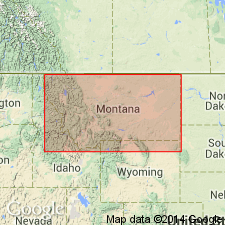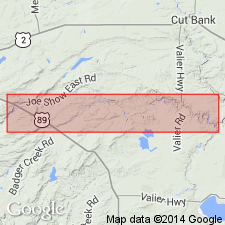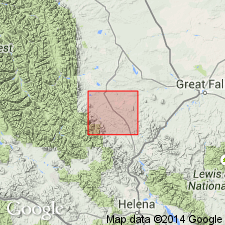
- Usage in publication:
-
- Horsethief sandstone*
- Modifications:
-
- Areal extent
- Dominant lithology:
-
- Sandstone
- AAPG geologic province:
-
- Sweetgrass arch
Summary:
Pg. 2337; see also Amer. Inst. Min. and Met. Eng. Trans., v. 46, p. 897, 1914. Lennep sandstone or Horsethief sandstone. Massive gray sandstone, 0 to 300 feet thick, overlying Bearpaw shale and underlying Lance formation. Lennep sandstone north of Crazy Mountains, in valley of Musselshell River, central Montana, is stratigraphic equivalent. [Age is latest Cretaceous (latest Montana age).]
Source: US geologic names lexicon (USGS Bull. 896, p. 982); supplemental information from GNU records (USGS DDS-6; Denver GNULEX).

- Usage in publication:
-
- Horsethief sandstone*
- Modifications:
-
- Principal reference
- Revised
- AAPG geologic province:
-
- Sweetgrass arch
Summary:
Pg. 62-68. Horsethief sandstone of Montana group. Forms bold escarpments and hogback ridges. Consists of gray to buff coarse-grained, much cross-bedded, massive sandstone in upper half, and slabby gray sandstone, becoming shaly toward base, in lower half. In places contains beds of heavy magnetite-bearing sandstone. Thickness 360 feet. Fossils mainly brackish, but in places it contains a marine littoral fauna. Overlies Bearpaw shale of Montana group and underlies continental deposits composing St. Mary River beds of Dawson, which occupy approximate stratigraphic position of Lance formation of Wyoming. Believed to correlate with Lennep sandstone of central Montana. Represents a great recession at the end of Pierre time. [Age is Late Cretaceous.] Report includes regional cross section.
Type locality: Horsethief Ridge, [Buffalo Lake 7.5-min quadrangle], Blackfeet Indian Reservation, Glacier Co., MT (Sweetgrass arch). Named from Horsethief Ridge [Lat. 48 deg. 47 min. 10 sec. N., Long. 112 deg. 42 min. 11 sec. W.]
Source: US geologic names lexicon (USGS Bull. 896, p. 982); supplemental information from GNU records (USGS DDS-6; Denver GNULEX).

- Usage in publication:
-
- Horsethief Formation
- Modifications:
-
- Redescribed
- AAPG geologic province:
-
- Montana folded belt
Summary:
Is mapped as formation in Montana Group in Lewis and Clark Co, MT in Montana folded belt province. Is redescribed (rank term changed from sandstone to formation) because of the variety of lithologic types present in area of this report. Along central and western parts of Dry Creek anticlinal trend the basal sandstones are gray, arkosic, and medium- to fine-grained; and contain abundant wood material, voluminous volcanic detritus, and scattered lenses of volcanic conglomerate and carbonaceous shale. Conglomeratic lenses with pebbles of vitrophyre and ash-flow tuff increase upward in number and thickness. Sandstones of upper part are light gray (5Y 6/1), volcanic-rich, arkosic, and coarse grained, and weather to massive outcrops with large calcareous concretions. Pebbly, iron-rich, conglomerate beds parting with a slabby habit cap the formation. Capping conglomerates are similar to those of the Adel Mountain Volcanics, but can be distinguished on basis of more evident stratification, abundant cobbles with well-oriented flow structure, zeolites compose mostly fine-grained matrix, and the Horsethief appears more deeply weathered. Fossils include brackish-water pelecypods and gastropods and shallow-water marine pelecypods. Age is Late Cretaceous.
Source: GNU records (USGS DDS-6; Denver GNULEX).
For more information, please contact Nancy Stamm, Geologic Names Committee Secretary.
Asterisk (*) indicates published by U.S. Geological Survey authors.
"No current usage" (†) implies that a name has been abandoned or has fallen into disuse. Former usage and, if known, replacement name given in parentheses ( ).
Slash (/) indicates name conflicts with nomenclatural guidelines (CSN, 1933; ACSN, 1961, 1970; NACSN, 1983, 2005, 2021). May be explained within brackets ([ ]).

